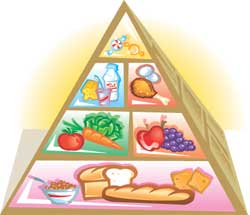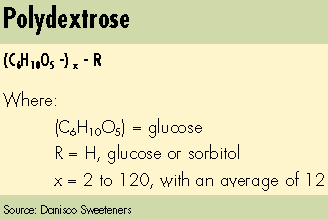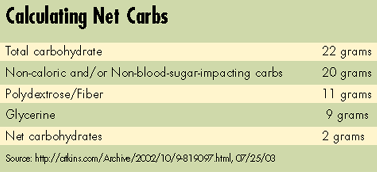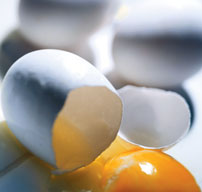

Why have low-carb diets taken the American public by storm? One might speculate the strong focus on low-fat foods during the 1990s (which occasionally approached a “fat phobia” in some people) left many fat gram counters devoid of the sensory pleasure that long-standing food favorites provide. Comparing the number of fat grams per serving of individual foods became a basis of competition between food brands within many food categories. The demand for low-fat and no-fat products spawned a massive industry development effort to reduce the fat content in order to meet government regulations for reduced- and low-fat claims.
Despite this frenzied effort to reduce our dietary fat intake, the U.S. Census Bureau (Washington) estimates that the prevalence of U.S. adults aged 20-74 who are overweight and obese today stands at 65%, and is projected to reach 73% by 2008 at the current rate. Some experts are holding the high-carbohydrate, low-fat regimen recommended by the Food Guide Pyramid as one of several factors responsible for the problem. The other widely-hypothesized culprits are larger food portion sizes in single-serve packaged foods and in restaurant fare (which correlate with increased calorie consumption), as well as increased physical inactivity at all ages.

Atkins and Net Carbs
The high-protein, low-carbohydrate diet first introduced in 1972 by Dr. Robert Atkins was ripe for resurgence after a decade of demonizing dietary fat. The Atkins diet solves several problems for consumers who have put on excess pounds. First, people who follow it see pounds disappear rapidly, with the lost weight coming first from body water and then from stored fat, without loss of muscle tissue. When carbohydrates supplying blood glucose are limited in the diet, the metabolism knows to begin to break down fat to keep the brain supplied with its basic fuel needs.The second reason for the success of the Atkins diet is that the higher fat and protein content satisfies appetites of dieters who rarely, if ever, feel hungry between meals. Protein and fat remain in the stomach longer than carbohydrates, and proteins take much longer than starches to convert to glucose when it is needed to maintain blood sugar levels.
A third, and perhaps overlooked, factor of the diet's success is that it gives consumers permission to consume the food favorites they have denied themselves for a long time. Thick steaks and three-egg omelettes with bacon have become regular fare, along with some high-fat sweets such as ice cream, chocolate mousse and whipped cream desserts, which are preferably sweetened with high-intensity sweeteners rather than sucrose to keep carbohydrate intake down.
Consumers, especially men, have embraced these diets in droves. Regardless of where the verdict comes in on efficacy, safety and compliance, consumers who have started these plans and reveled in their weight loss now seek a wider variety of foods that allow them to stick with the program that brought them success.
Food product formulators have been busy developing products to be lower in carbohydrates, specifically the so-called “high-glycemic” carbohydrates derived from sugars or starches that are known to convert rapidly into blood glucose once digested. Keeping blood glucose at a low end of the normal range favors the breakdown of fat stores which, in turn, helps create the mild state of nutritional ketosis that results when fat is being burned for fuel. The Nutrition Facts Panel on food product labels requires a listing of total carbohydrates calculated by difference from standard proximate analyses (100% - %moisture, %protein, %fat, %crude fiber and %ash), and the dietary fiber and total sugar content per serving. Sugar alcohols and other carbohydrates can be listed on a voluntary basis. Food technologists need to remember that nutritionally speaking, not all carbohydrates captured on the package label are the same with regards to their glycemic potential. The term “net carbohydrates” has become popular because of the Atkins Net Carbs Seal® that marks packages with the number of grams of carbohydrates that will convert rapidly to blood glucose.

Minimizing Glycemic Carbs
When trying to minimize the glycemic carbohydrates in products for carb counters, formulators can choose from a number of helpful ingredients. These include a wide array of carbohydrates from dietary fibers, such as pectins, gums, certain cereal brans, and soluble hemicelluloses found in vegetables, fruits and grains. Glycerin (also called glycerol) also qualifies and offers humectant properties. Sugar alcohols, such as xylitol, maltitol, sorbitol, mannitol, isomalt and lactitol, vary in sweetness content and can sometimes be used as a one-for-one sugar replacer. Resistant starches are designed to escape digestion and, therefore, behave like many dietary fibers. Polydextrose, an alpha 1-6 linked chain of glucose units that is not broken down by starch-digesting enzymes in the small intestine, also can be used.
Some product categories are easier to reformulate than others. Nutrition bars and beverages are the least difficult, and low-carbohydrate, sugar-free or no-added sugar versions of these were among the first to come to market. Bars can be sweetened with high-intensity sweeteners, and some of the bulk of the sucrose these sweeteners replace is provided by bulking agents such as polydextrose, inulin or fructose oligosaccharides. Sugar alcohols, or polyols, also can be used for their bulk and humectant properties, but may cause digestive discomfort—including flatulence or laxative effects—in some sensitive individuals who do not consume them regularly.

Formulation Approaches
Sugar-free beverages have been on the market for years, from soft drinks to dairy drinks. High-intensity sweeteners such as aspartame, acesulfame K and now, sucralose, provide sweetness. Low-level use of gums such as carrageenan, gum Arabic, guar, xanthan, or other hydrocolloids, helps provide the desired mouthfeel or body to the beverage.Generally, gravies and savory sauces are thickened with native or modified starches that add a modest carbohydrate level. Formulators can experiment with gums, vegetable purées, and resistant starches to achieve the desired flavor and texture, while reducing net carbs to minimal levels. Dessert sauces can be formulated with high-intensity sweeteners. Sucralose is known for its heat stability, and should work well for chocolate or other dessert sauces that may require heat processing. Since carbohydrates are the ingredients of concern—rather than fat—formulators can be more liberal with the use of dairy and other fats to provide a rich, full-bodied sauce that enhances flavor release.
Non-chocolate confectionery products fall into many categories. Sugar-free hard candies can be made with polydextrose, and flavors, colors and high-intensity sweeteners can be added as the mixture cools. Oligofructose also can be used in hard candy formulations as well as in softer, chewier products. Though some modified starches usually form the base of gumdrops and other “gummy” candies, formulators might experiment with sucrose reductions using heat stable, high-intensity sweeteners, and dairy proteins to replace a significant portion of the starches and reduce carbohydrates.
The standard of identity for chocolate may be problematic from a labeling standpoint for some candy formulations; however, sugar-free chocolate confections have been made for years, and their popularity is growing as flavors improve. High-intensity sweeteners can be formulated successfully into chocolate, and sugar alcohols (usually maltitol or lactitol) also have been used as sugar replacements in chocolate confections for many years. Sucrose can be replaced with blends of polyols, high-intensity sweeteners and inulin, or polydextrose to eliminate the cooling effect that polyols alone can have, and the aftertaste associated with some sweeteners. The result is a compound coating or confection that tastes closer to real chocolate!
Other product categories offer different challenges. Sugar-free or reduced-sugar jams and jellies have been on the market for a long time, using special pectin preparations and high levels of fruit and fruit juice concentrates for sweetness. Further reduction of carbohydrates from the fruit may present challenges to maximizing finished product flavor and color. Formulations that stray from the standard of identity requirements will require some creativity in a product name that is attractive to consumers.
Dairy products contain lactose, or milk-sugar, which converts to glucose and galactose on digestion. Low-lactose dairy products have had the lactose already converted to these two monosaccharides, so crafting a product that is technically sugar-free will not be possible. However, the undaunted food technologist could try to “build” a yogurt-like dessert or snack, a dairy-based beverage or dessert that minimizes lactose content from milk. Strategies include increasing the use of milk proteins, gums and hydrocolloids or gelatin for viscosity, high-intensity sweeteners, and vegetable or milk fat (an ingredient that can be brought back to the formulator's tool kit after a decade of avoidance). Sugar-free frozen dairy desserts that utilize sugar alcohols and polydextrose now are on the market. The rich texture and mouthfeel afforded by heavy cream can be considered for these products, since the formulation objective is low carbohydrates rather than low fat.

Low Carbohydrate-based Foods
The most challenging categories for reducing carbohydrates are whole-grain or extruded breakfast cereals, certain bakery products and salty snacks. The cereals are primarily carbohydrate from the starchy endosperm portion of the grain. The high-protein, lower-carbohydrate germ fraction of wheat has been lightly toasted and marketed plain or lightly sweetened for years, but the high-protein germ portion of oats, rice, corn and barley have not found similar success.Ready-to-eat cereals high in wheat bran also have proliferated, but not without some floury endosperm and sweetener present to enhance flavor and texture. Resistant starches are finding a place in extruded cereal manufacture. Sweetened cereals could reduce some glycemic carbohydrates present by coating the finished flaked, puffed, or extruded product with solutions or coatings of high-intensity sweetener to the desired sweetness level, instead of sucrose.
White breads and rolls can reduce carbohydrate content by adding additional wheat gluten and other dietary fibers such as resistant starches at the expense of flour, and/or substituting some non-wheat flours, such as soy. These changes may compromise the delicate color and crumb structure of soft white breads when added at high levels. Adding grains and fibers to whole grain breads makes carb reduction in these varieties less difficult, because coarser textures are expected for these products.
Baked sweet goods such as cakes, cookies and muffins have come a long way since the development of heat stable, high-intensity sweeteners, bulking agents and resistant starches that complement sweetener use by contributing structure and texture. Sugar-free products now are available at the retail level from in-store bakeries, with branded products expected to follow.
Salty snacks are based primarily on refined carbohydrates. The addition of protein to extruded snacks may dilute the carbohydrate content somewhat; however, high levels could make the finished product hard or tough. While it is hard to make a potato chip without potatoes, or corn chips without corn, they can still be enjoyed occasionally by carb counters if they can design some room within their daily carb limit (usually about 50g) to indulge once in a while.
As always, watch the regulatory details, especially if the product you have in mind to “de-carbohydrate” has a standard of identity or you use ingredients that have special labeling requirements. Remember that “net carbohydrates” is not part of the nutrition facts panel, and your claims must pass muster as truthful and not misleading. The good news is that in addition to protein, formulating with a little fat is now “O.K.” This means that low-carb consumers just might continue to savor your creations even after they start counting something else!

Website Resources
www.tiax.biz—Home page for TIAX with information on food development serviceswww.nal.usda.gov:8001/py/pmap.htm— USDA's Food Guide Pyramid
http://atkins.com- Atkins-brand foods for consumers
http://atkins.com/Archive/2002/10/9-819097.html— Page with Atkins' Net Carbs Seal
www.cbsnews.com/stories/2003/05/21/eveningnews/main555030.shtml— CBS news story summarizing New England Journal of Medicine studies supporting Atkins diet
www.PreparedFoods.com/newsletter/articles/0403/0403_6b.htm — Study that counters aspects of Atkins diet
www.PreparedFoods.com/ newsletter/articles/0303/0303_6a.htm — Study supporting usefulness of high-fat and protein diets in newborns
www.eatright.org/Public/NutritionInformation/92_nfs0200b.cfm— American Dietetics Association's page arguing against low-carb diets
www.PreparedFoods.com/archives/2003/2003_5/0503hitting.htm — New Atkins-brand products in 2003
www.PreparedFoods.com/newsletter/articles/0403/0403_7d.htm — Press release on a low-carb chocolate sauce